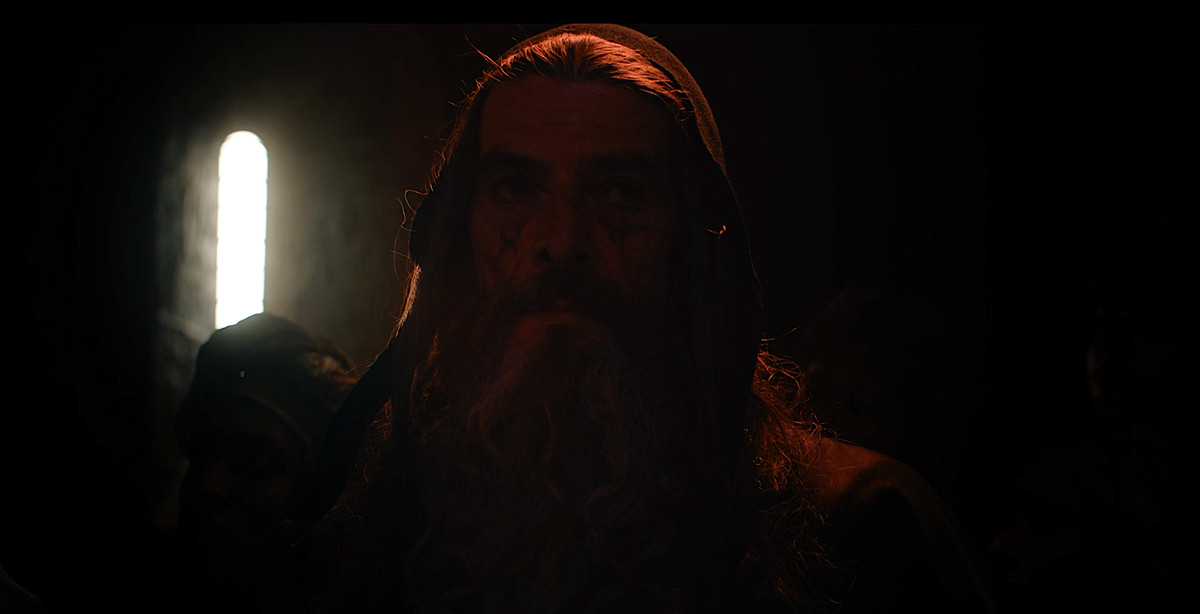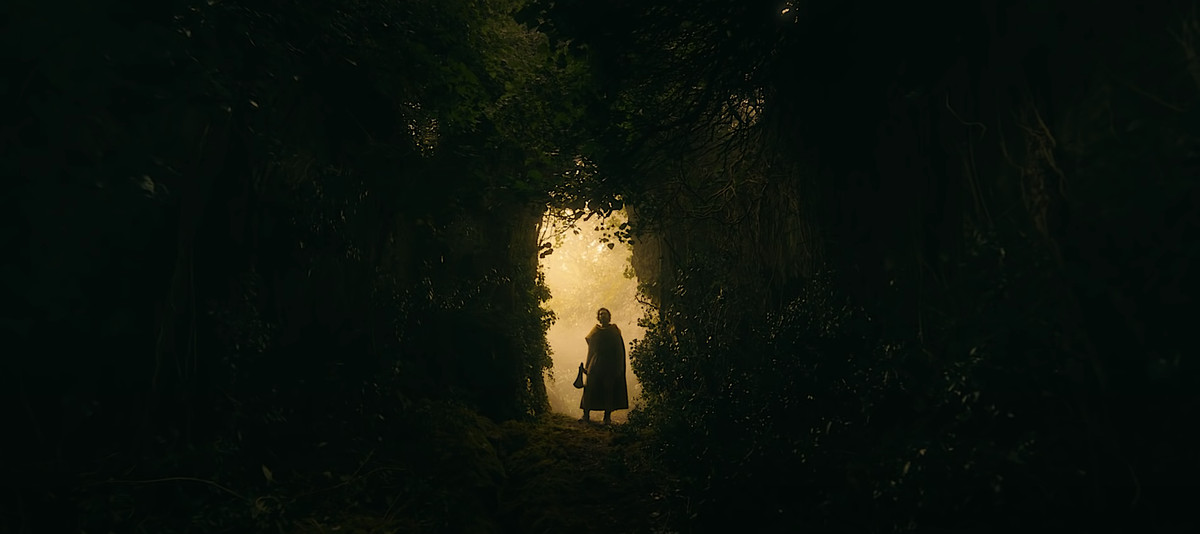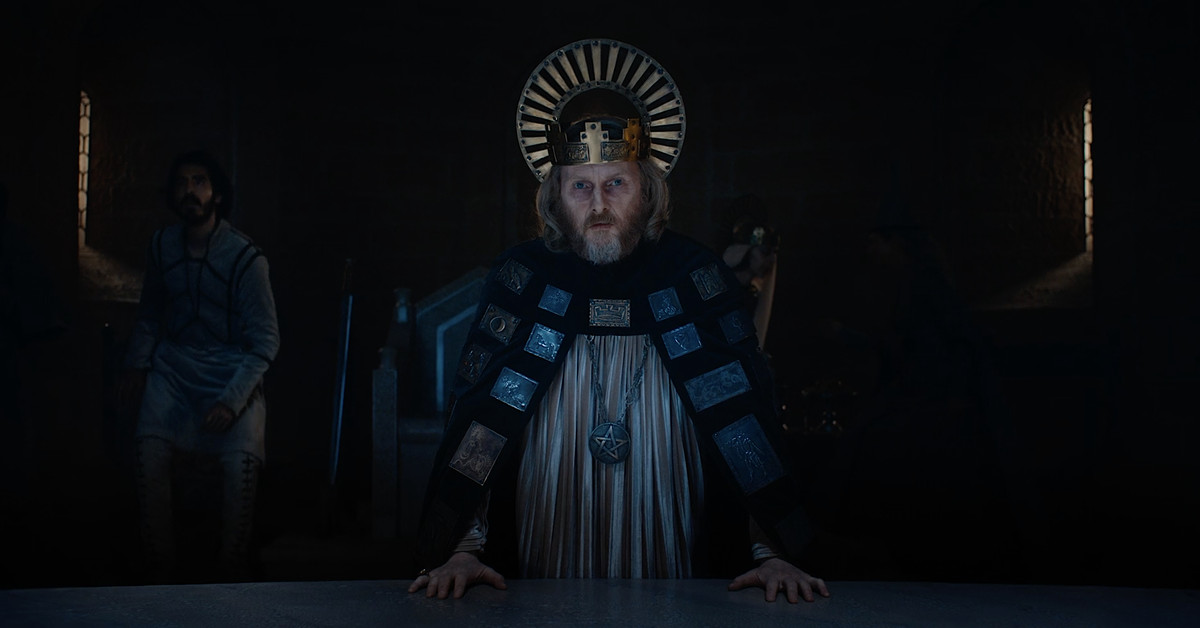Here’s a question most of us will never face: What do you do when you’re making a film and technical difficulties instantly shut down everything you planned to shoot on a day? For The Green Knight director David Lowery and cinematographer Andrew Droz Palermo, the answer was “Set the star’s head on fire.”
Palermo, who also worked with Lowery on his stunning low-key fantasy A Ghost Story, says The Green Knight’s very first shot had to be put together on the fly after the day’s shooting plans got scrapped.
“We had an accident with the underwater tank that we were planning on shooting [Green Knight star Dev Patel] swimming in, to fetch St. Winifred’s head,” Palermo tells Polygon. “The water went green with some kind of mold, it was no longer clear. So we said ‘Shit, what can we film? Well, let’s do the dream sequence.’ We had it scripted, we knew we were going to do it, we just weren’t prepared for it. So it came together quite quickly.”
Palermo describes that opening sequence as “a rather simple shot, just a simple push in,” but the image is a haunting, startling one: Would-be knight Gawain (Dev Patel) sitting grimly on a throne in King Arthur’s Great Hall, with a crown slowly descending onto his head from above. When he’s crowned, his head bursts into flames, but he continues to stare at the audience, unblinking. It looks like the kind of sequence that would normally be created with extensive CGI, but Palermo says he and Lowery shot all the elements with practical effects, on the day they discovered their water tank was unworkable.
“Everything we did was done through special effects on the set,” he says. “The crown descending on his head, so you can actually feel the shadows on his hair, was on a wire system. Then we took Dev out of the shot and repeated it, with a dummy head that we lit on fire, and the two got put together geniusly by [VFX house] WETA. And then we tilt up to the oculus in the ceiling, and WETA put in the starry sky above.”
All Palermo’s behind-the-scenes stories about The Green Knight have this same quality of extensive planning meeting on-the-fly decisions. The meticulous thought that went into the film is clear on the screen, given the richly toned visuals and the carefully color-coded symbolism. But the actual shooting and assembly of the film was a mixture of instinct-based experiments and late-game improvisation. Palermo says his early conversations with Lowery were essentially a puzzle, with no guarantee that there was a solution.
He first mentioned he wanted a large format,” Palermo says. “I knew what he was thinking about, about the scope of the visuals, and wanting them to feel very wide. But then he laid down a challenge about also wanting it to feel very three-dimensional. And he didn’t really clarify that puzzling idea, he just floated it out there one day, and I kept prying at it from different angles and moods. [Mimicking Lowery looking over his work] ‘Ahhhhh, that’s not exactly what I need.’ It was a fun thing to pick at.”
Palermo says the three-dimensional idea didn’t come into focus until the two men went to Ireland together, to scout out shooting locations. “With the idea that the movie was going to be quite wide, I had very wide lenses with me as we scouted, and that was a really fun way to start making a movie together. I’d take a photo I liked a lot of a landscape and show him, and I could see he was excited about the progress.”
Palermo says location scouting is the best part of working with a director on a project: “It’s really a chance to get to know each other if you don’t already. You can take your time — you don’t need to feel like everything’s super-pressured, and that you’ve got to ask all your questions and give them all your ideas immediately. You’re stuck in a van together for weeks on end, going from place to place. I really just like to get to know a person and understand where they’re coming from for film.”
That process helped him work out some aspects of the film with Lowery, like the vivid colors of certain scenes — red for dark magic, green for natural magic, yellow for a poisonous scene where nature turns unnatural, blue for a melancholy hallucination where Gawain sees a band of pale giants trudging off into the mist.

Photo: A24
“It’s such a big swing, the color,” Palermo says. “I love it. That was a mantra through the whole movie: “What is the hard choice here? We should go for it, and we should lean into it really hard. Not every one of them connects, I think we know, but I’m so glad I tried some really tougher ideas.”
Palermo says the amber color design of the film’s finale was the first one he and Lowery decided on. “That look was inspired partially by [cinematographer Vittorio] Storaro at the end of Apocalypse Now, when [the protagonist is] at the end of his journey, and it becomes very hot, very humid, kind of psychedelic. I challenged myself to never look at the film while I was thinking about it, so I just tried to have my memory of what it looked like. And that led me to someplace that excited me, which is so vastly different from Storaro’s look, made it its own unique thing. I wanted it to feel very feverish, so you could question — was it even real?”
The other color-coded shots in the film came later. “With that amber finale color in mind, I worked backward,” Palermo says. “I looked at the beginning of the movie and thought, ‘How can I think about the magic in the film? How can we make the Green Knight feel a certain way? And how can I position other scenes against these two? What’s the palette we’re suggesting?
“So greens are is obvious. It’s the simplest thing I could have done, probably. Greens became the earthy pagan colors, and reds became more evil magics. When Merlin does a spell early in the Great Hall, there’s this red light. I liked that we made that era of Camelot evil. They’ve gone too far — logged the entire forest, clean-cut the whole landscape, and they’ve lost touch with nature. That helped color-code their world as well.”

Photo: A24
A great deal of that world was shot on location. Palermo says the only primary sets built for the movie were King Arthur’s Great Hall, where Gawain first encounters the Green Knight, and the interior of St. Winifred’s cottage, where Gawain is given a challenge to complete. Other shots are assemblages of real spaces. For instance, the surreal cliff where Gawain sees the giants was stitched together from footage of different continents.
“We shot that in Wicklow on the top of a mountain,” Palermo says. “It’s actually an old 13th- or 14th-century path. In that shot, Gawain is facing what is now the town of Bray. So in the valley below would have been the city, which had to get scrubbed out. Some of it was replaced by WETA, with landscapes from New Zealand. So it’s a weird amalgam of Ireland and New Zealand that they kind of smashed together. But for me, at least starting with something real is so important, as opposed to it being fully generated in a computer. That gives it some texture that you just can’t fake.”
The Green Knight has prompted a great deal of analysis, viewers picking apart its symbols and its relationship to its source material, a 14th-century poem that’s been translated and interpreted many times, including by Lord of the Rings author J.R.R. Tolkien. Palermo suggests that fans looking for Easter eggs watch for two things. First, as Gawain travels from the jaded, decadent court to the wilds where he finds his honor, the film gradually adds moss as a signifier of his return to the natural world.
“With Jade [Healy], the production designer, I was looking for a way to have the presence of green moss be more and more apparent as the film goes on. The first shot after the introduction is largely the gray interior of a brothel, and that courtyard out back, where the building’s on fire. As the camera tracks back, you’ll see the very tiniest bit of moss growing in. That was me thinking, ‘This is where we’re headed. This is the first aspect of where we’re going to go eventually, into this very lush, verdant world.’”

Photo: A24
Second, Palermo suggests watching for the gradually softening edges of the frames throughout the movie. “There’s a lot of light contrast at the beginning, especially in the Great Hall, but the light becomes more and more natural-feeling and softer as the film goes on,” he says. “The lenses become softer. There’s a language in the way the lenses roll off on the sides. It becomes even more painterly and expressionistic. That’s me wanting to push the movie more and more toward psychedelic as we go.”
For more traditional Easter eggs, Palermo points to that first scene after the hallucinatory opening of Gawain on the throne. In that sequence, the camera pulls back from a burning village, past a woman mounting a horse and a man drawing a sword, and fixes on Gawain, asleep in the brothel.
“During that shot, in the courtyard, there’s a drunk guy up against the shed,” Palermo says. “That’s [Tomas Deckaj], our first AD. He really wanted to play that drunk. And Joe Anderson, the cinematographer of The Old Man and the Gun — one of David’s other films, which I love dearly — plays Paris, the man who draws the sword. He just happened to be there visiting his wife. I forget what happened with the original actor, but David was like, ‘Joe, you’re going to get dressed up, and you’re going to be in this scene.’ I’m so glad he was there. It was such a treat for me to see him every time we were coloring the movie.”
That dream sequence is yet another example of how Lowery and his crew mixed planning with improvisation on The Green Knight — not just because of the last-minute cast replacement, but in what happened to the scene afterward. Lowery has helped decode many of the movie’s biggest mysteries, including what happens at the end. But audiences have particularly wondered about the identities and meaning behind the man and woman in the burning village, who don’t appear in the rest of the movie. As the credits show, they’re Helen of Troy and her kidnapper Paris, from Greek myth, and the sequence is a dream of catastrophe Gawain is having, before his lover Essel wakes him up by dumping water on his head.
Palermo says that before Lowery devised that opening shot with Gawain’s crown and his burning head, Paris and Helen’s sequence was the first shot of the movie “for so very long,” after being moved from other places in the story.
“We could never find a home for this dream sequence,” he says. “Originally it was in the middle of the movie. Morgan le Fay is touching Gawain’s head, and you understand that she’s implanted this vision in his mind, so he would be fearful of what would come if he didn’t succeed on his quest. But then David had the idea to utilize that sequence in the beginning. A friend of his gave him a note that he needed more of a setting of the stage. So David put it there instead. And it does really set you off in a scary, intense way.”
The Green Knight is now available for premium digital rental on streaming platforms like Amazon and Vudu.
Polygon – All
Source link
Related Post:
- 10 NAUGHTY Easter Eggs We CAN'T UNSEE
- 7 Most Elaborate Easter Eggs That Are Nearly Impossible
- Space Jam 2’s weird Bugs Bunny Game Boy game cameo, explained
- 5 great movies that inspired Green Knight on Disney Plus, HBO Max, and Amazon
- Sex and sensuality in The Green Knight: David Lowery lays out a morality tale
- Green Knight, Netflix’s Sweet Girl and 13 new movies you can now watch at home
- Green Knight and fantasy films struggle to match Dungeons & Dragons fun
- The Green Knight is available to stream for one night only
- The Stalker 2 trailer features a cameo from the series’ creator
- Random: The Internet Is Dunking On Space Jam 2’s Game Boy Cameo
